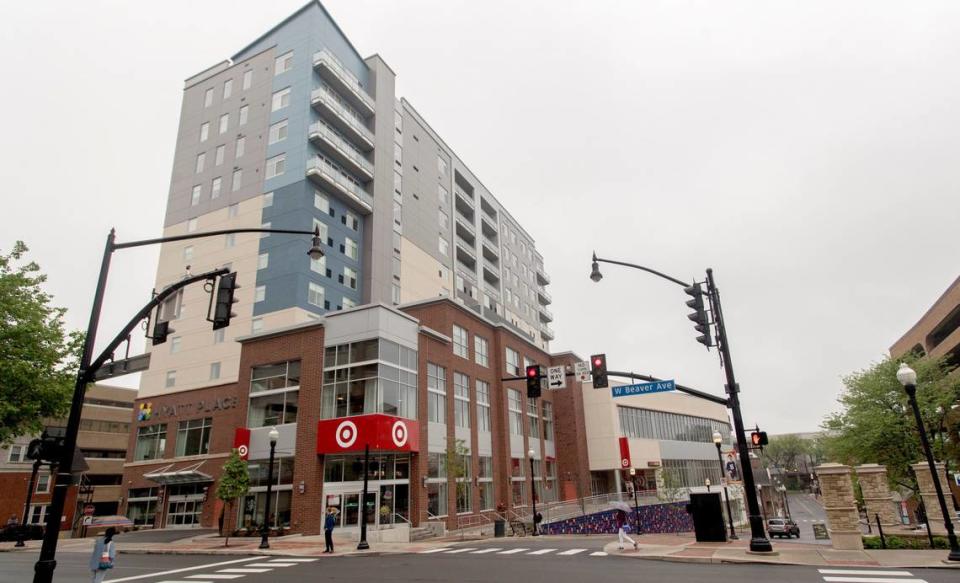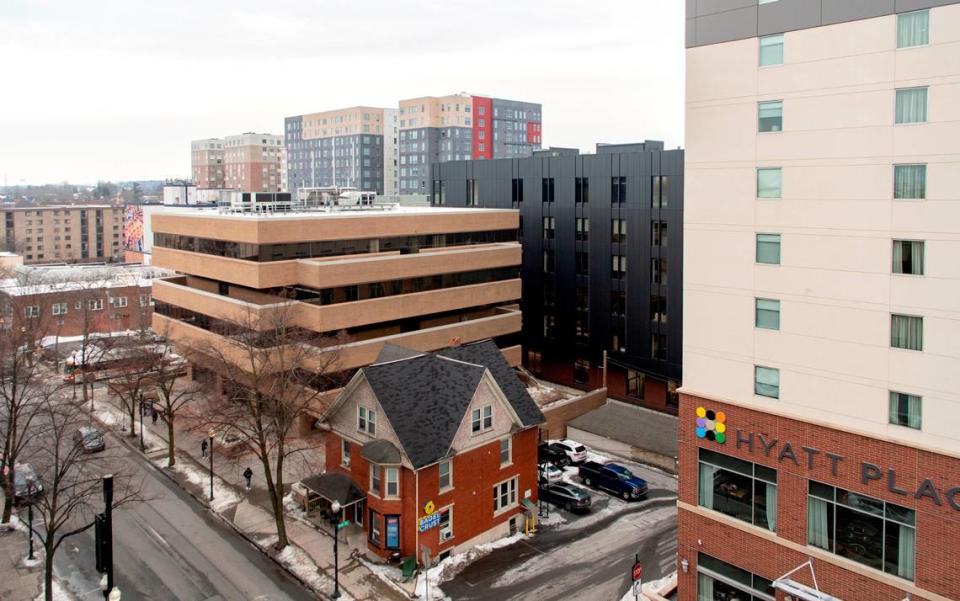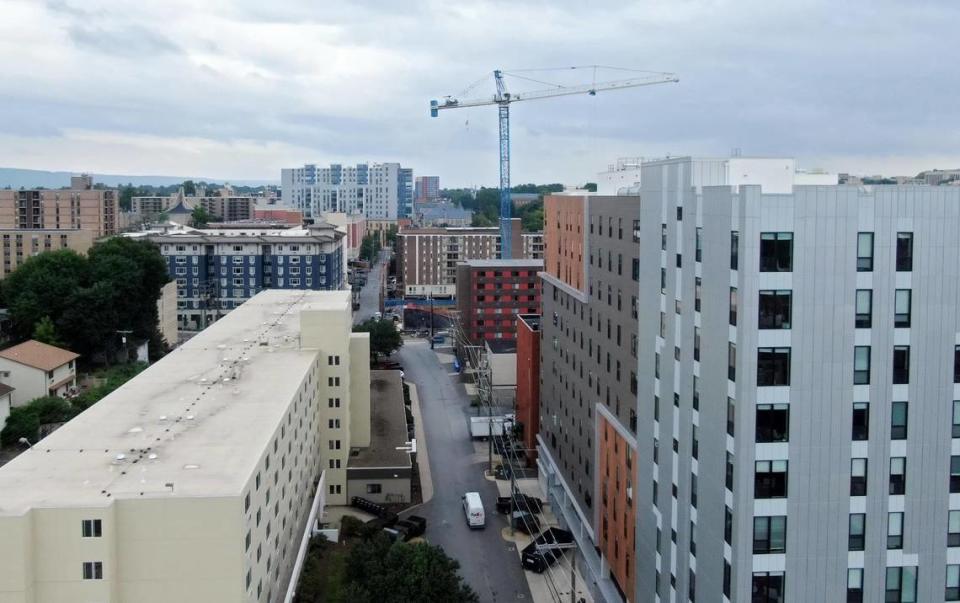Is State College oversaturated with Penn State student housing? Officials share concerns
Although Penn State’s enrollment at University Park has largely remained flat for more than two decades, student housing in downtown State College is booming. A handful of 12-story high-rises have added hundreds of new units, prompting local officials and residents to raise concerns about oversaturation in the once-small town.
Those worries are becoming increasingly alarming for some locals, who question Penn State’s steady enrollment in contrast to the continued influx of student housing. Now, with its downtown district changing rapidly, State College is at a crossroads.
A changing landscape
Although State College has undoubtedly grown over the past few decades, its development hastened once the Fraser Centre came into fruition.
The complex, situated at 217 W. Beaver Ave., is home to the 158-room Hyatt Place Hotel, a Federal Taphouse restaurant, a Target store complete with a Starbucks and CVS pharmacy, more than two dozen condominium units and a ground-floor Planet Fitness that’s expected to replace an H&M store. But the Fraser Centre’s completion would not have been possible without a landmark exception adopted by the borough council.
In 2005, the council passed the Signature Project Overlay, which allowed buildings of up to 12 stories within a 10-block area of downtown if developers dedicated 40% of buildings’ gross square footage to commercial use. Amendments to the provision would later expand the ordinance’s scope and require developers to work inclusionary and rental housing spaces, among other conditions, into their buildings.
With a new zoning code to work with, the landmark Fraser Centre finally received a green light and opened in 2016. But some local officials, including Associated Realty Property Management (ARPM) President Mark Bigatel, say the borough’s urgent efforts to support the Fraser Centre’s construction overlooked the effects development could produce.
“They did it for one building not knowing the unintended consequences, which opened up the rest of the downtown market,” said Bigatel, whose company manages hundreds of properties in the State College area. “Large developers came in and saw an opportunity, so they built these buildings. Until then, local developers met the needs of student housing demand, mostly in a tasteful, thoughtful way.”

Bigatel says that new high-rises like the Metropolitan or the Standard, both located at the intersection of College Avenue and South Atherton Street, bring more students into the downtown area. The borough’s newest student housing complexes often include amenities like rooftop pools and indoor fitness centers, and with close proximity to campus, they’re becoming increasingly attractive options for Penn Staters.
But they often come with high price tags that can price out some students who once called the downtown district home.
Per-bedroom rates at the Metropolitan, which opened in 2017, can reach nearly $1,600 a month, while rent for studio apartments sits near $2,000. Per-bedroom rates at the Standard, the borough’s newest high-rise apartment building, top out at nearly $2,100 a month.
“High-rises are very expensive to rent. Penn State used to be a cross-section of students from all over the state. What we have seen in our rental market is that students who can afford to come to Penn State, especially with rising tuition and housing costs ... it’s more like an Ivy League school now,” said Bigatel, noting that ARPM properties generally market low- and mid-range rents.
Increased development in the area is not limited to the borough’s downtown district. Newer developments in Ferguson Township and Patton Township, including the Yards at Old State or the View, also offer student housing. Officials approved final plans for a six-story student housing complex on West College Avenue last year, and an unrelated seven-floor apartment building, also intended along West College Avenue, could soon receive approval, too.
Changing neighborhoods rank among the top concerns for State College officials in charge of guiding the borough’s current efforts to rewrite its zoning codes. The ongoing process hopes to address quick-paced growth in the downtown district and establish construction incentives that would persuade developers to work affordable housing and energy-efficient facilities into their blueprints.
A Penn State graduate and State College native, Bigatel said he hopes legislative changes will help the borough shift the bulk of its focus away from students.
Oversaturating a housing market
Consistent pushes for increased State College development in recent years have surprised some local officials, including Ed LeClear, the borough’s planning director. Developers from across the country view the area as a high-potential market that could support student-centric housing thanks to its close proximity to Penn State’s campus.
“I’m still consistently amazed by the number of phone calls I get on a weekly basis from new developers that work in student housing that I’ve never heard of,” LeClear said. “I’m eight years in. I thought I would’ve talked to almost all of them, and I’m still getting new ones. That tells you there’s a huge demand to get into the State College and regional markets.”
One of LeClear’s leading concerns, though, is the risk that too much housing could pose for the borough. Overbuilding could result in a housing market that no longer meets the needs of a community, potentially forcing tenants out and speeding up changes in an area that’s sometimes unrecognizable to those who called it home just a few decades ago.
Some effects of market saturation are already observed in State College, LeClear said. Through indirect work and conversations with developers, he says he’s learned some high-rise apartment buildings in the area can produce profits while operating at lower occupancy levels — even when dipping down near 80% in some cases. Those complexes could risk becoming a losing investment if a market would become so saturated that there were not enough tenants to fill vacancies.
“I know the numbers work for some developers with occupancy rates down in the 80s. They can still make money, but we’ve never historically had those kinds of rates,” said LeClear, who is not directly involved in housing development. “In a very short amount of time, we’re going from vacancy rates in some buildings of about 1% or 5-to-6%, which is considered healthy, to maybe much more than that. As a community, we’ve never experienced that before.”

Occupancy rates aren’t yet a major concern for the borough’s newest high-rises. Leasing agents from the Standard and the Metropolitan recently indicated their buildings are about 98% full for the fall 2022 semester, LeClear said.
However, more traditional complexes that aren’t as close to campus may struggle to attract tenants.
“What I’ve heard is that some of the older stock, especially buildings further out into the townships, have been struggling with occupancy,” LeClear said.
New high-rises in the area present challenges for older buildings that could have a harder time keeping pace. Complexes farther away from the downtown district, as well as those that date back decades, are at an increased risk of becoming obsolete, potentially adding another variable to an already-complex equation.
Bigatel said competition from new developments in State College has prompted local property managers to take action.
“You cannot have a 1980s apartment anymore and expect to get a decent rent or even a tenant anymore,” Bigatel said. “Our company does a huge number of remodeling projects to touch up older properties. Everything from flooring, kitchens, utilities and so on. It’s the older properties that are getting remodeled that will continue filling up.”
State College’s supposed demand for student housing is unique in that it doesn’t necessarily correlate with growth on Penn State’s campus.
The university’s enrollment nearly doubled from about 15,000 students in 1960 to about 30,000 students in 1973, all before surpassing the 40,000-student mark in 1997. But in the 20-plus years since then, University Park’s enrollment has stalled, largely teetering somewhere between approximately 40,000 and 47,000 students.
Penn State President Neeli Bendapudi recently appointed Matt Melvin as the university’s next vice president for enrollment management after serving in a similar role with the University of Kansas. He’ll lead the school’s newly formed Enrollment Management Office to examine and develop the university’s enrollment plans.
On Friday, the university declined to comment on Penn State’s enrollment strategies, noting it is “a bit premature” to offer details on plans or projected numbers while the newly formed office gets situated.
However, a spokesperson confirmed Penn State has no current plan to expand on-campus housing at University Park. The university is currently renovating a handful of dormitories in its East Halls complex before turning its attention toward refurbishing other aging facilities throughout the next decade.

As the head of a local property management firm, Bigatel watches the State College market carefully. He says it may be only a matter of time before student housing development slows down if Penn State’s enrollment remains steady.
“We still have roughly the same number of students in our community, but development is drawing more and more of them to this downtown, concentrated area,” Bigatel said. “I think (the market) will level out. There are a few more buildings going up now, and I think that upper-end market is going to get saturated fairly soon.”
Market saturation wouldn’t necessarily be a bad thing for the borough. Although it poses risks for developers who hope to cash in, a leveled-out market could help stabilize or lower rent rates and adjust a housing market that may have previously boxed out tenants.
Greater job growth in the Centre Region — especially independent from Penn State — would also help in those stabilization efforts, LeClear said.
“My hope is that you’re going to see naturally occurring affordable housing in some of those buildings that would bring downward pressure on rent,” LeClear said. “You might start to see them get leased up by non-student populations. The question there, though, is whether or not there’s that demand.”
What’s next for the borough?
The future of State College’s housing market largely relies on the borough’s efforts to overhaul its zoning codes — a process that’s about five years in the making. Any changes would be significant since, outside of 200-plus small amendments, the bulk of the current zoning ordinance originated in 1959.
Code adjustments would ideally strike a balance between many competing objectives, including shorter, less dense buildings, more affordable housing for non-student residents and energy-efficient buildings of a better quality. With goals set, officials are now working with consultants to find compromises to produce new zoning codes that would attract developers and support the market. LeClear said he hopes to see a completed draft submitted by 2023, but a potential adoption is hard to forecast.

LeClear said he hopes zoning adjustments might help State College fill its commercial spaces, especially those that sit vacant at the bottom of mixed-use high-rise buildings downtown.
“When you look at the entire region, there’s probably an oversaturation of land that is zoned for non-residential and commercial uses,” LeClear said. “When you look at the total number of the square footage of commercial space, it’s a lot. I really question if we have the demand for that. Municipalities want to zone for commercial spaces because it brings in more tax revenue, and that’s historically been the case here.”
Speaking for himself, Bigatel wants to see local officials restrict building heights in the downtown area. Noting their profits, though, he’s not too optimistic.
“Those buildings bring a lot of dollars into the area. It’s hard to tell if the borough really wants to change that,” he said.

